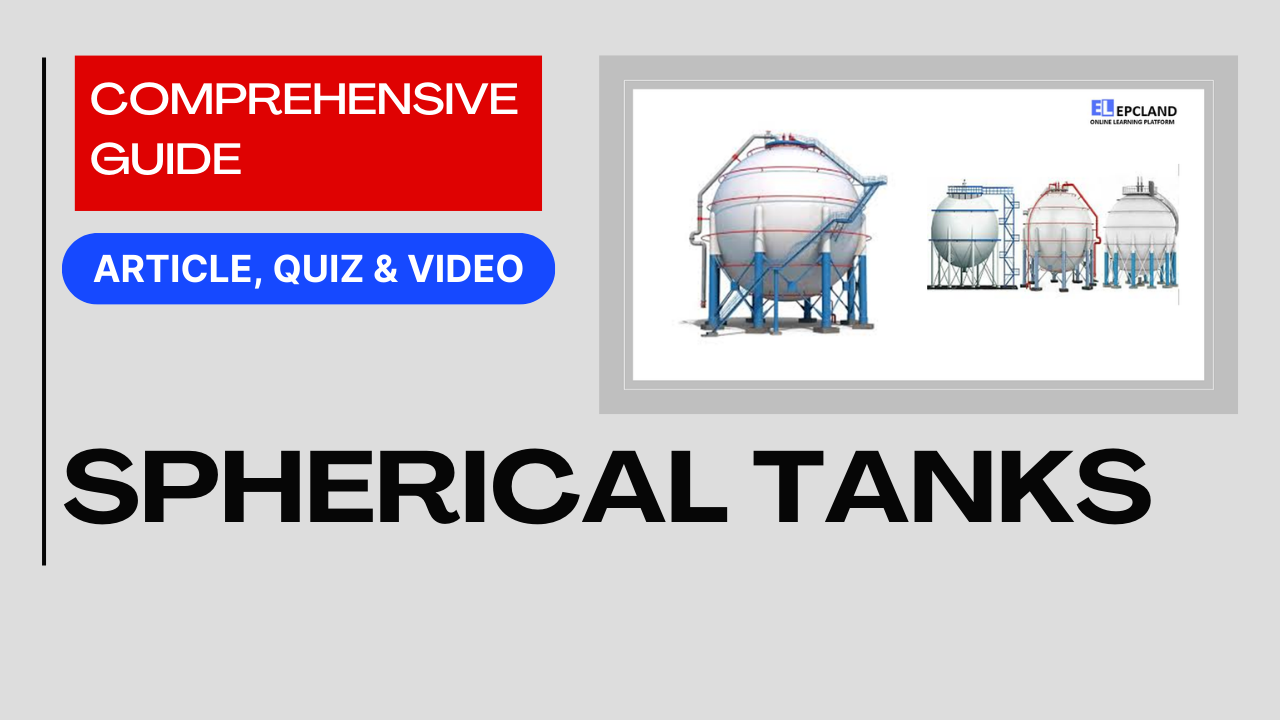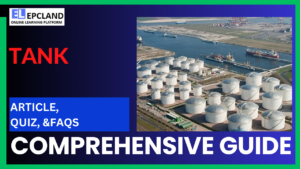Abstract
Spherical tanks, with their unique design and engineering, have played a significant role in various industries for storing and transporting liquids and gases. This article aims to provide an in-depth exploration of these tanks, including their components, advantages, drawbacks, adherence to codes and standards, historical accidents, lessons learned, and a thorough comparison with other types of storage tanks.
1. Introduction
Spherical tanks have a rich history and have been a crucial part of industrial infrastructure. In industries such as oil and gas, petrochemicals, aerospace, and cryogenic storage, these tanks have demonstrated their efficiency and reliability in storing pressurized liquids and gases. The primary focus of this article is to delve into the engineering aspects, safety considerations, and practical applications of spherical tanks in modern industries.
Table of Contents
Do not miss the detailed course on Tank Farm Layout & Stress Analysis
Enrollment link
Check out Similar Articles on other Storage Tanks
2. Spherical Tank Components
Spherical tanks are composed of several key components that collectively ensure their functionality and integrity. These components include:
- Shell: The spherical shell is the defining feature of these tanks. It distributes stress evenly, minimizing weak points.
- Support Structure: Spherical tanks rest on a support structure that bears the weight of the tank and its contents.
- Access Ports and Manholes: These provide entry points for maintenance, inspection, and repairs.
- Nozzles and Connections: Nozzles are used for inlet, outlet, and instrumentation connections.
- Drainage and Venting Systems: Essential for managing liquid and gas flows within the tank.
Table 1: Components of a Spherical Tank
| Component | Function |
|---|---|
| Shell | Distributes stress evenly, ensuring structural integrity |
| Support Structure | Bears the weight of the tank and its contents |
| Access Ports & Manholes | Allow entry for maintenance, inspection, and repairs |
| Nozzles & Connections | Provide points for fluid inlet, outlet, and instrumentation |
| Drainage & Venting Sys. | Manage liquid and gas flows within the tank |

3. Pros and Cons
Advantages
- Structural Integrity: The spherical shape ensures even stress distribution, enhancing stability and strength.
- Reduced Footprint: Spherical tanks have a smaller footprint compared to other tanks of the same volume, making them ideal for limited spaces.
- Natural Seismic Resistance: The shape offers inherent resistance to seismic forces, a crucial consideration in earthquake-prone regions.
- Efficient Material Use: Spherical tanks require less material per unit volume, reducing construction costs.
- Improved Thermal Performance: The shape minimizes heat transfer, suitable for storing cryogenic substances.
Drawbacks
- Complex Fabrication: Constructing spherical tanks requires specialized manufacturing processes, increasing fabrication complexity.
- Limited Capacity: Spherical tanks are less suitable for very high-capacity storage needs due to their shape constraints.
- Transportation and Installation Challenges: Transporting and installing spherical tanks can be logistically challenging and expensive.
Table 2: Pros and Cons
| Pros | Cons |
|---|---|
| Even stress distribution | Complex fabrication process |
| Reduced footprint | Limited capacity for certain applications |
| Natural seismic resistance | Transportation and installation challenges |
| Efficient material use | |
| Improved thermal performance |
Do not miss the detailed course on Tank Farm Layout & Stress Analysis
Enrollment link
4. Codes and Standards
Adherence to codes and standards is paramount in designing and operating spherical tanks to ensure safety and reliability. Some of the key standards include:
- API 620: This standard provides guidelines for the design and construction of large, welded, low-pressure storage tanks.
- ASME Section VIII Division 1: A part of the ASME Boiler and Pressure Vessel Code, it covers the design of pressure vessels.
- EN 14015: This European standard specifies the design and manufacture of site-built, vertical, cylindrical, flat-bottomed, above-ground, welded, steel tanks for the storage of liquids at ambient temperature and above.
Table 3: Relevant Codes and Standards
| Standard | Description |
|---|---|
| API 620 | Design and construction of large, welded, low-pressure storage tanks |
| ASME Section VIII Div. 1 | Design of pressure vessels |
| EN 14015 | Design of site-built, vertical, cylindrical, above-ground, welded, steel tanks |

5. Historical Accidents and Lessons Learned
Notable Accidents
- Feyzin Disaster (1966): An explosion at a spherical tank storing liquefied petroleum gas resulted in multiple fatalities and significant damage.
- Texas City Disaster (1947): The explosion of a ship carrying ammonium nitrate led to a catastrophic chain reaction that affected nearby spherical tanks and caused extensive destruction.
Lessons Learned
- Safety Measures and Inspections: The accidents emphasized the importance of rigorous safety measures and regular inspections.
- Mitigating Failure Points: Identifying and addressing potential failure points in tank design and operation is crucial.
- Community Awareness and Emergency Response: Engaging the community and having effective emergency response plans are vital for minimizing the impact of accidents.
Table 4: Historical Accidents Involving Spherical Tanks and Lessons Learned
| Accident | Lessons Learned |
|---|---|
| Feyzin Disaster (1966) | Rigorous safety measures and regular inspections are crucial |
| Texas City Disaster (1947) | Identify and address potential failure points |
| Engage the community and have effective emergency response plans |
Do not miss the detailed course on Tank Farm Layout & Stress Analysis
Enrollment link
6. Comparative Analysis with Other Tank Types
Comparison Criteria
- Structural Integrity: Spherical tanks excel in stress distribution and overall strength.
- Footprint and Space Utilization: They offer a smaller footprint compared to some other tank types.
- Maintenance and Inspection Ease: Spherical tanks may have accessibility challenges for maintenance.
- Environmental Impact: They can be more environmentally friendly due to efficient material use.
Comparison with Other Tank Types
- Cylindrical Tanks (Vertical and Horizontal): These tanks have larger footprints and uneven stress distribution but are simpler to fabricate.
- Bullet Tanks: Bullet tanks have higher capacity than spherical tanks but can be more prone to stress concentration.
- Cryogenic Tanks: Spherical tanks are well-suited for cryogenic storage due to their low heat transfer.
- Underground Tanks: Spherical tanks eliminate the need for excavation, making them more suitable for above-ground applications.
Table 5: Comparison of Spherical Tanks with Other Tank Types
| Criteria | Spherical Tanks | Cylindrical Tanks | Bullet Tanks | Cryogenic Tanks | Underground Tanks |
|---|---|---|---|---|---|
| Structural Integrity | High | Varied | Moderate | High | Moderate |
| Footprint & Space Utilization | Small | Larger | Moderate | Small | Moderate |
| Maintenance & Inspection Ease | Challenging | Easier | Easier | Easier | Easier |
| Environmental Impact | Efficient | Varied | Varied | Efficient | Varied |
7. Modern Applications of Spherical Tanks
Spherical tanks continue to be integral to various modern industries:
- Oil and Gas: Used for storing liquefied petroleum gas (LPG) and other hydrocarbons.
- Petrochemicals: Spherical tanks store chemicals and feedstock for petrochemical processes.
- Aerospace: Used for propellant storage in rockets and spacecraft.
- Cryogenic Storage: Suitable for storing liquid nitrogen, oxygen, and other cryogenic substances.
8. Future Trends and Innovations
The future of spherical tanks holds several exciting possibilities:
- Advanced Design: Continued development of materials and designs for enhanced strength and safety.
- Automation and Monitoring: Integration of automation and digital monitoring systems for real-time data collection.
- Sustainability: Incorporation of sustainable materials and practices in tank manufacturing to reduce environmental impact.
9. Conclusion
Spherical tanks, with their distinctive shape and engineering, have proven their worth across various industries. While they come with certain complexities and limitations, their unique advantages make them indispensable for specific storage needs. By adhering to stringent codes and learning from historical accidents, the industry can continue to harness the benefits of spherical tanks while ensuring safety and reliability.
Do not miss the detailed course on Tank Farm Layout & Stress Analysis
Enrollment link
FAQs
1. What is a spherical tank, and why is its shape unique?
A spherical tank is a storage vessel with a perfectly round shape resembling a sphere. Unlike traditional cylindrical or rectangular tanks, the spherical shape ensures even stress distribution across its surface, contributing to enhanced structural integrity. This unique shape also offers inherent resistance to seismic forces, making it suitable for earthquake-prone regions.
2. What are the main advantages of using spherical tanks?
Spherical tanks offer several advantages, including:
- Structural Integrity: The even stress distribution due to their shape enhances stability.
- Reduced Footprint: They occupy less ground space compared to tanks of similar capacity.
- Seismic Resistance: Their shape provides natural resistance to seismic forces.
- Material Efficiency: They require less material for construction, reducing costs.
- Thermal Performance: Spherical shape minimizes heat transfer, making them suitable for cryogenic storage.
3. What are the drawbacks of using spherical tanks?
While spherical tanks have numerous benefits, they also come with certain drawbacks:
- Complex Fabrication: Constructing spherical tanks involves specialized manufacturing processes, increasing complexity.
- Limited Capacity: Due to their shape, they may not be suitable for very high-capacity storage needs.
- Transportation Challenges: Transporting and installing spherical tanks can be logistically challenging and expensive.
4. How do spherical tanks compare with other tank types?
In a comparative analysis, spherical tanks have distinct characteristics compared to other tank types:
- Structural Integrity: Spherical tanks excel in even stress distribution.
- Footprint and Space Utilization: They have a smaller footprint than some other tank types.
- Maintenance and Inspection: Accessibility for maintenance might be challenging.
- Environmental Impact: Their efficient material use makes them more environmentally friendly.
5. What safety standards govern the design and operation of spherical tanks?
The design and operation of spherical tanks adhere to various safety standards, including:
- API 620: Provides guidelines for the design and construction of large, welded, low-pressure storage tanks.
- ASME Section VIII Division 1: Covers the design of pressure vessels, including spherical tanks.
- EN 14015: Specifies the design and manufacture of above-ground, vertical, cylindrical, welded, steel tanks for liquid storage.
Recommended courses (Published on EPCLand)
- Basics of Piping Engineering
- Piping Layout Engineering
- Piping Material Engineering
- Piping Stress Analysis
- Complete Course on Piping Engineering
- Material Requisitions
- Piping Material Specifications
- Valve Material Specifications
Don’t miss the published articles on following:
Related Video
Attempt Quiz
Question 1:
What is a spherical tank?
Explanation: A spherical tank is a type of storage tank that has a spherical shape, providing uniform stress distribution and efficient use of space.
Question 2:
What is the advantage of a spherical tank over other tank shapes?
Explanation: One of the advantages of a spherical tank is its efficient stress distribution, which allows it to withstand high internal pressures and provides safety benefits.
Question 3:
What is the primary application of spherical tanks?
Explanation: Spherical tanks are primarily used for the bulk storage of liquids and gases, such as liquefied petroleum gas (LPG), liquid nitrogen, and more.
Question 4:
What is the main consideration in designing a spherical tank?
Explanation: The main consideration in designing a spherical tank is achieving uniform stress distribution to ensure its structural integrity and ability to handle internal pressure.
Question 5:
What is a common material used for constructing spherical tanks?
Explanation: Stainless steel is a common material used for constructing spherical tanks due to its corrosion resistance and durability, making it suitable for storing a wide range of liquids and gases.



